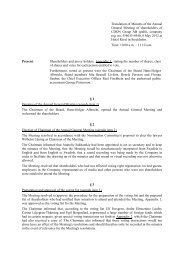Annual Report 2010 - CDON Group
Annual Report 2010 - CDON Group
Annual Report 2010 - CDON Group
Create successful ePaper yourself
Turn your PDF publications into a flip-book with our unique Google optimized e-Paper software.
54 <strong>CDON</strong> <strong>Group</strong> AB<br />
<strong>Annual</strong> Årsredovisning report <strong>2010</strong> <strong>2010</strong><br />
2.4 Consolidation principles and business combinations<br />
Subsidiaries<br />
Subsidiaries are companies over which <strong>CDON</strong> <strong>Group</strong> AB has a controlling interest. Controlling interest means, directly or indirectly,<br />
the right to formulate a company’s financial and operational strategies with the aim of receiving economic benefits. When judging<br />
whether there is a controlling interest, potential voting shares that can be used or converted immediately are taken into account.<br />
Acquisitions on or after 1 January <strong>2010</strong><br />
Subsidiaries are recognised using acquisition accounting. With this method, acquisition of a subsidiary is regarded as a transaction<br />
whereby the <strong>Group</strong> indirectly acquires the subsidiary’s assets and assumes its liabilities. The acquisition analysis establishes the fair<br />
value of acquired identifiable assets and assumed liabilities on the acquisition date, as well as any non-controlling interest.<br />
Transaction expenses, except for transaction fees attributable to issued equity or debt instruments, are recognised directly in<br />
profit/loss for the year.<br />
In business combinations in which the transferred payment, any non-controlling interest, and fair value of previously held interest<br />
(for incremental acquisitions) exceeds the fair value of acquired assets and assumed liabilities that are recognised separately, the<br />
difference is recognised as goodwill. When the difference is negative, it is recognised directly in profit/loss for the year.<br />
Compensation transferred in connection with the acquisition does not include payments for the settlement of past business<br />
relationships. This type of settlement is recognised in profit/loss.<br />
Contingent considerations are recognised at fair value on the date of acquisition. In cases where contingent considerations are<br />
presented as equity instruments, no revaluation is done and adjustments are made in equity. Other contingent considerations are<br />
revalued at each reporting date and the change is recognised in profit/loss for the year.<br />
Non-controlling interest arises in cases where the acquisition does not include 100% of the subsidiary. There are two options for<br />
recognising non-controlling interest: (1) recognise the non-controlling interest’s share of proportional net assets, or (2) recognise<br />
non-controlling interest at fair value, which means that non-controlling interest is part of goodwill. Choosing between the two<br />
options for recognising non-controlling interest can be done individually for each acquisition.<br />
The acquisition of Lekmer AB on 31 March <strong>2010</strong>, where non-controlling interest amounted to 9.9%, was recognised at fair value.<br />
For incremental acquisitions, goodwill is determined on the date control is taken. Previous holdings are assessed at fair value and<br />
changes in value are recognised in profit/loss for the year.<br />
Disposals leading to loss of controlling interest but where holdings are retained are assessed at fair value, and the change in value is<br />
recognised in profit/loss for the year.<br />
Acquisitions completed before 31 December 2009<br />
For acquisitions made before 31 December 2009 in which the acquisition price exceeds the fair value of acquired assets and<br />
assumed liabilities as well as contingent liabilities that are recognised separately, the difference is recognised as goodwill. When the<br />
difference is negative, it is recognised directly in profit/loss for the year.<br />
Transaction expenses, except for transaction fees attributable to issued equity or debt instruments, are included in the acquisition<br />
price.




